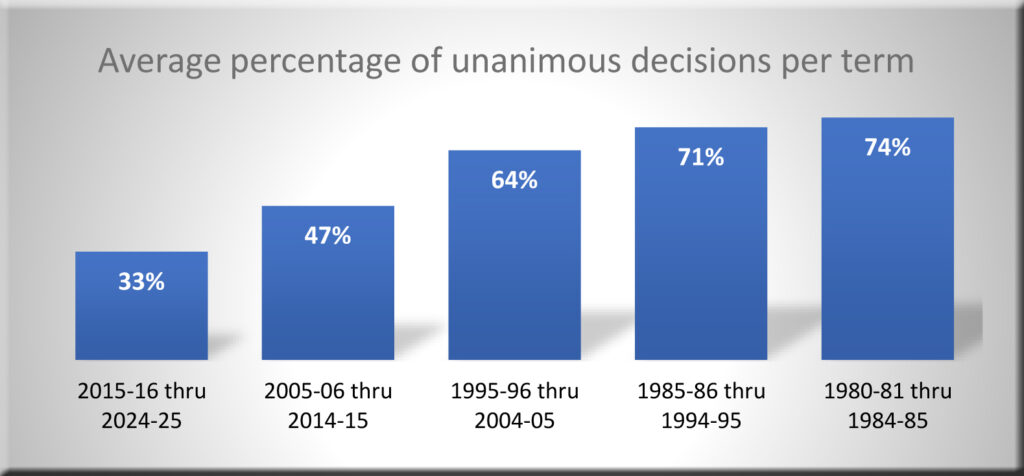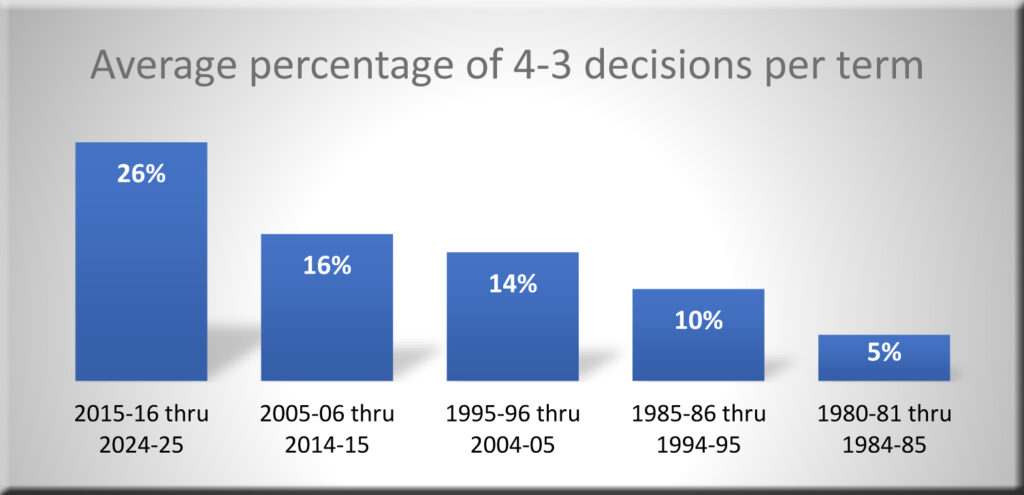At a time when the Wisconsin Supreme Court has been described as polarized, dysfunctional, and politicized,[1] some commentators have noted that fully 36% of decisions were unanimous in 2024-25—consistent with levels in previous terms and a larger share, they suggest, than might have been expected in a partisan atmosphere. Indeed, given that more decisions last term were reached unanimously than by any of the other possible vote margins, such observations on unanimity could even prompt one to question whether “polarized,” “dysfunctional,” and “politicized” are les mots juste when characterizing the court.
How typical is 36%?
The figure of 36% certainly approximates the average percentage of unanimous decisions over the past decade (33%),[2] but a look farther back creates a different impression. We’ll confine our attention to the last 45 years, following the advent of the court of appeals at the end of the 1970s that relieved the supreme court of hundreds of comparatively routine cases each term. (Prior to that, the justices commonly filed 90% or more of their decisions unanimously.)
As shown in Chart 1, a much larger percentage of the court’s decisions were unanimous just twenty years ago—and during the 1980s and 1990s the average more than doubled that of recent years.[3]
4-3 decisions
Incidentally (but not surprisingly), the ascension of unanimity in preceding decades was accompanied by a plunge in the percentage of 4-3 decisions—which fell from 26% in the most recent decade to a mere 5% in first half of the 1980s (Chart 2).[4]
Does a high percentage of unanimous decisions indicate a healthier court?
Or, to put it more precisely, is a 36% rate of unanimity high enough in this regard? We’ve already encountered one complication with such optimism—36% is actually very low compared to the average for any other decade in the past century. However, another objection works in the opposite direction, challenging the inference that a higher percentage of unanimous decisions is more desirable, denoting an allegedly healthier court.
While it is easy to demonstrate that the current level of unanimity at the supreme court is nowhere close to typical for the court of appeals era, it is much harder to decide what percentage of unanimity is optimal. Does a high degree of unanimity imply a collegial court, adept at finding common ground through respectful consideration of every member’s views? Or does frequent unanimity stem from a set of justices who represent only a small range of concerns held by the state’s citizens? Perhaps both? Maybe it signals a court reluctant to break new ground or accept “politicized” cases. Would this be good or bad? Opinions will differ widely as to how many of these things are beneficial, and whether they apply to a particular set of justices. But such questions should arise when confronting claims linking levels of unanimity and the health of a court.
[1] See for example Joy Powers and Sam Woods, “Episode 7: Money talks,” WUWM 89.7, June 12, 2024 (“politicized” and “polarized”); “Chief Justice Annette Kingsland Ziegler: Statement,” WisPolitics, August 2, 2023 (“dysfunctional”); and Tom Kertscher, “Wisconsin’s Supreme Court has become hyper political. The rise and fall of Michael Gableman’s career shows how that happened,” WISCONSIN WATCH, April 16, 2025 (“politicized”).
[2] This is an average of the annual percentages, not weighted by the number of decisions in each year.
[3] The last bar in the chart (for 1980-81 through 1984-85) covers only five terms so as not to extend back beyond the inception of the court of appeals.
[4] Here is a chart showing the percentages for 6-1 (or 5-1, 4-1) and 5-2 (or 4-2) decisions and a chart showing the percentages for every possible vote split in every individual term.


Speak Your Mind